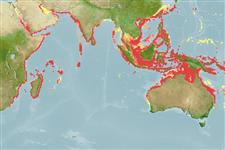>
Eupercaria/misc (Various families in series Eupercaria) >
Haemulidae (Grunts) > Plectorhinchinae
Etymology: Plectorhinchus: Greek, plektos = plaited + Greek, rhyngchos = snout (Ref. 45335).
More on author: Forsskål.
Issue
This species appears to be restricted to southeast Africa to the Arabian Sea, including the Red Sea and Persian Gulf. Junior synonyms Plectorhinchus unicolor (Macleay, 1883) and Plectorhinchus griseus (Cuvier, 1830) are considered valid according to Johnson et al., 2015 (Ref. 103290). Species record and information will be repaired accordingly.
Environment: milieu / climate zone / depth range / distribution range
पारिस्थितिकी
समुद्री; खारा प्रवाल-भित्ति संयुक्त; गहराई सीमा 0 - 80 m (Ref. 9710). Tropical; 30°N - 32°S, 29°E - 160°E
Indo-West Pacific: eastern Africa south to Port St. Johns, South Africa and east to the western Pacific.
आकार / वज़न / Age
Maturity: Lm ? range ? - ? cm
Max length : 80.0 cm TL पुल्लिंग / अलिंग; (Ref. 9710); common length : 60.0 cm TL पुल्लिंग / अलिंग; (Ref. 5450)
Found around rocks and corals from the surf zone to a depth of 80 m (Ref. 2799). Enters estuaries and rivers in Seychelles, Madagascar and South Africa (Ref. 2135). Juveniles occur in tide pools (Ref. 9710).
Life cycle and mating behavior
परिपक्व अवधि | पुनरुत्पत्ति | मछलीऔ का अंडे देना | अंडे | Fecundity | लार्वा
Oviparous, distinct pairing during breeding (Ref. 205).
Masuda, H., K. Amaoka, C. Araga, T. Uyeno and T. Yoshino, 1984. The fishes of the Japanese Archipelago. Vol. 1. Tokai University Press, Tokyo, Japan. 437 p. (text). (Ref. 559)
IUCN Red List Status (Ref. 130435: Version 2024-2)
Threat to humans
Harmless
Human uses
मात्स्यिकी: व्यापारिक; आखेट मत्स्य: हां
साधन
Special reports
Download XML
इंटरनेट स्रोत
Estimates based on models
Preferred temperature (Ref.
123201): 24.3 - 29, mean 27.9 °C (based on 1644 cells).
Phylogenetic diversity index (Ref.
82804): PD
50 = 0.5000 [Uniqueness, from 0.5 = low to 2.0 = high].
Bayesian length-weight: a=0.01413 (0.00689 - 0.02895), b=3.00 (2.83 - 3.17), in cm total length, based on LWR estimates for this Genus-body shape (Ref.
93245).
Trophic level (Ref.
69278): 3.8 ±0.49 se; based on food items.
लौटाव (Ref.
120179): निम्न, न्यूनतम जनसंख्या दुगनी होने का समय 4.5 - 14 वर्ष। (Preliminary K or Fecundity.).
Fishing Vulnerability (Ref.
59153): Moderate to high vulnerability (52 of 100).
Climate Vulnerability (Ref.
125649): High to very high vulnerability (74 of 100).
Nutrients (Ref.
124155): Calcium = 23.7 [8.4, 46.1] mg/100g; Iron = 0.46 [0.24, 0.82] mg/100g; Protein = 19.6 [17.7, 21.4] %; Omega3 = 0.134 [0.074, 0.225] g/100g; Selenium = 39.1 [22.5, 65.7] μg/100g; VitaminA = 58.5 [21.1, 164.2] μg/100g; Zinc = 1.13 [0.78, 1.64] mg/100g (wet weight);
